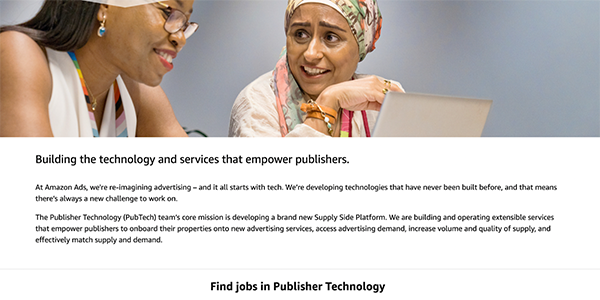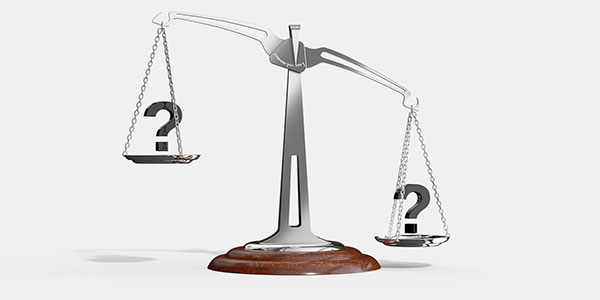 |
||||||||||||
|
||||||||||||
| Amazon’s Confusing PubTech Team |
 |
| The News: Amazon is quietly building a publisher-focused ad products team, reported Lauren Johnson of Business Insider. The group, known as PubTech, will have a core mission (per Amazon) of developing a brand-new SSP. Initially, Amazon listed job postings indicating that the new SSP would work with first-party publishers on Amazon's properties and third-party publishers not on Amazon's properties. And Johnson pointed out that the new SSP could compete with Google, Pubmatic, and others. From reading this news, it's clear that Amazon doesn't yet know what its SSP will do. The job listings make it clear that candidates will have wide-ranging freedom to reimagine a new world and to pioneer novel experiences for publishers to sell video, audio, and display ads. One promises "a unique opportunity with greenfield development to influence the vision, capabilities, and architecture," while another says they can expect a "scrappy" environment. The Walkback: After the story was published, Amazon contacted Business Insider to say that the PubTech SSP wouldn't serve all publishers after all, prompting the publication to issue a correction stating: "Correction, August 11, 2023: After this story was published, Amazon said the SSP is meant for its own properties and not third-party publishers as originally stated in its job postings. An Amazon spokesperson said that the company would amend its job postings." At least one job posting does appear to be amended, saying the candidate will build supply-side technology, but it is catered to "Amazon first-party publishers (e.g. Prime Video, Freevee, FireTV, Twitch)." The landing page introducing the PubTech jobs is much more ambiguous and limits the SSP to just Amazon properties. It says, "We are building and operating extensible services that empower publishers to onboard their properties onto new advertising services, access advertising demand, increase volume and quality of supply, and effectively match supply and demand." This ambiguity has some people in the industry on edge, wondering what Amazon's ultimate plan for its SSP is. No one would go on record openly to question Amazon's plans, as many rely on Amazon's existing Transparent Ad Marketplace (TAM) to find buyers for their inventory. |
| Amazon already offers a suite of publisher services, including its Transparent Ads Marketplace, which pools ad inventory from multiple publishers and exposes it to their advertisers. Its server-side header bidding solution for publishers allows publishers to make their inventory available to multiple ad exchanges simultaneously. It also integrates with existing SSPs and consolidates the bidding process across them. “Amazon already has code on a lot of publisher sites,” an industry insider who asked not to be identified told AdMonsters. “I can’t see the purpose of building an SSP if not to service all publishers, including those outside their network.” Another executive, also speaking on background, thought a key goal for Amazon is to expand the number of pages where their code is deployed to gain access to more data to develop its own large language model (LLM). “In a world where people are talking about using data to educate large language models LLM, it just seems to make sense that you want to have tags in lots of places,” he said. “In many ways, AI is the real solution for cookieless targeting because we really don’t need to know anything about the people advertisers target. The more you learn about people’s behavior patterns, you don't need to know about specific people.” |
|
| Does the Supply Side Dominate the Ad Tech Supply Chain? |
 |
| Ad tech veterans on both sides of the supply chain have often drawn adversarial lines between publishers and advertisers. The ANA's Programmatic Media Supply Chain Report takes this notion one step further, painting the buy and sell sides as separate entities working on different playing fields. Sell-Side v. Buy-Side: According to the study, the skewed distribution of power stems from information asymmetry — the study of decisions in transactions where one party has more or better information than the other. Simply put, the study highlights that publishers tend to have better information about the quality of media inventory sold in auctions. ANA writes in the study, "If buyers cannot properly access the price of the goods in question (i.e., programmatic inventory and audiences), they tend to overpay. If buyers cannot know enough about the underlying quality of the goods being sold, particularly in auctions, they cannot know how to price it with any precision or certainty." Why is it like this? The study asserts that the ad tech supply chain is complicated and under-regulated. Essentially the supply chain is a "complicated, decentralized, highly technical system composed of many disparate players that is subject to minimal oversight or regulation." |
| The question remains: How can we clean up the supply chain to create an even balance of power between publishers and advertisers? As industry veteran Jana Meron wrote for AdMonsters, there are too many players with not much-differentiated value, and that has led to a bloated supply chain. Meron believes this diluted system hinges on the lack of knowledge about the web as an ecosystem and the fact that ad tech experts have built the web into isolated silos. Thus, it is more challenging for publishers and advertisers to generate revenue. "Publishers need to be aware of what's happening in the market, within the digital ecosystem, to ensure its health and safety," said Meron. "We cannot turn a blind eye to understanding how revenue is generated, who the players are, what differentiates them, and which companies continue to support the ecosystem for the better." It will benefit both the buy and sell sides. |
| Generative Ai Isn't Taking Creative Writer's Jobs yet, and Probably Not Yours Either |
| When ChatGPT launched last November, writers everywhere wondered if this was the end of their livelihood. It even prompted Hollywood writers to go on strike. But according to new research from Freelancer.com, AI just can't match the creativity of humans. Freelancer.com looked at 280,000 jobs posted to its site and found that in the second quarter of this year, creative writing jobs are up 58%, and other writing jobs are up 38%. Ghostwriting is up nearly 23%. "AI can't replace creativity yet. While workers and businesses are benefiting from productivity gains offered by generative AI, the data suggests that the technology in its current form isn't able to replace creative work. We saw a similar trend occur in the first quarter of the year, as creative design jobs were flourishing despite interest for generative AI tripling," Matt Barrie, Chief Executive at Freelancer.com, says in the report. What's more, many freelance writers are earning serious money. CNBC found writers on the site who charge a rate of $250 per hour. CNBC also notes that, in some instances, generative AI is creating new work for writers. The freelance site Fiverr has seen an 80% increase in postings for writers who can edit the content that ChatGPT produces. |
| We've pretty much heard the same when it comes to revenue and advertising operations — generative AI cannot replace human work, but instead enhance it. For example, at AdMonsters' recent Publisher Forum at Coronado Island, Major League Fishing's Jared Collett, showcased using ChatGPT to effortlessly generate personalized email responses, suggest ad products, craft compelling value proposals, create HTML templates, fix ad delivery issues with JavaScript code, and so much more. While everyone is lauding generative AI as a major game changer for the advertising industry, many projects that would revolutionize the industry are merely experiments at this point. Also, humans are still needed to feed the platform information and guide it in delivering results. |
| Around the Water Cooler |
| Is Print Advertising Making a Comeback? Many tend to link the resurgence of old past times to nostalgia, but not in the case of print advertising. Brands like Nordstrom and Zappos are reevaluating their marketing strategies and turning to print marketing. (Digiday) X (Twitter) Shuts Down Promoted Accounts Ad Business In a surprising industry shakeup, X (Twitter) has announced discontinuing its $100 million Promoted Accounts advertising business. Why are they giving up this major revenue source? (Axios) New York City Bans Tik Tok On Government-issued Devices Tik Tok has faced significant scrutiny over the years, but this battle is still undecided. Amid free speech and jurisdiction concerns, New York City's TikTok ban faces intricate legal challenges. (Tech Crunch) |
 |
|||
|
|||
 |
|||
 |
|||
|
| @{optoutfooterhtml}@ |







